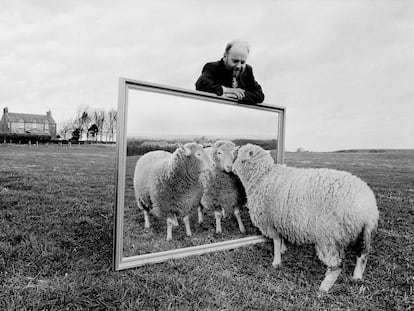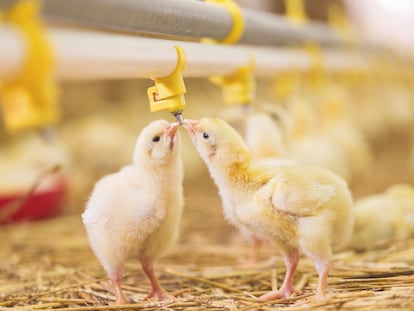The birth of Retro, a cloned monkey that presents the possibility of cloning humans
A group of Chinese researchers has perfected the technique for producing identical macaques but says that cloning people would be ‘completely unacceptable’

On Tuesday, a team of Chinese scientists announced the birth of Retro, a macaque cloned with a new strategy to obtain identical monkeys. Lead researcher Qiang Sun explains to EL PAÍS that the cloning of human beings would be “completely unacceptable” and says that doing so is not in their plans. “We won’t even think about it,” he says.
The 1996 cloning of Dolly the sheep caused a worldwide alert about the possibility that a laboratory might try to make clones of human beings. The technique seemed simple. British embryologist Ian Wilmut’s group emptied an egg from a sheep and inserted a nucleus with DNA from an adult cell taken from another female’s udder. Dolly was a replica of the latter. The first calves and mice were cloned in 1998, followed by goats in 1999, pigs in 2000, rabbits in 2002 and dogs in 2005. In 2007, the United Nations University published a report stating that the cloning of human beings was, perhaps, inevitable.
Over two decades ago, some irresponsible scientists, such as Italian gynecologist Severino Antinori and American biologist Panos Zavos, even announced the imminent birth of cloned humans, but the reality was that Dolly’s technique — called somatic cell nuclear transfer — did not work well with primates, the animal group that includes monkeys and humans. That situation changed in 2018, when the same Qiang Sun team announced the birth of the first monkeys cloned using this strategy: two female crab macaque monkeys christened Zhong Zhong and Hua Hua. The word zhonghua means “Chinese nation.” At the time, one of the study’s co-authors, Poo Mu-ming, declared in this newspaper that “there are no barriers to cloning primates, so human cloning is closer to becoming a reality.”
The 2018 experiment was extremely inefficient. Qiang Sun and colleagues created 109 embryos, transferred 79 of them to 21 females, and achieved just six gestations. Only two monkeys were born. In the new study, published on Tuesday in the Nature Communications journal, the researchers improved the technique by adding placental precursor cells. This time they created 113 embryos, transferred 11 of them to seven females and achieved two gestations and a single birth: a male rhesus macaque monkey, who is now three and a half years old. “This new strategy has significantly improved the efficiency of monkey cloning, both with respect to the number of embryos transplanted and the number of pregnant females used,” says Sun.
The Chinese researcher explains that they named the animal Retro, after the acronym for replacement of the trophectoderm, the layer of cells that gives rise to the placenta. “Retro is growing and getting stronger every day. He lives in our animal house with ample space and sunlight,” says the Chinese scientist, the director of the non-human primate facility at the Center of Excellence in Brain Science and Intelligence Technology in Shanghai.
This new strategy has significantly improved the efficiency of monkey cloning”Qiang Sun, Chinese scientist
German bioengineer Angelika Schnieke, one of the people involved in cloning Dolly the sheep, was concerned about Qiang Sun’s first experiments, which required dozens of pregnant females and largely resulted in miscarriages and malformed fetuses. “These cloned primates in China have crossed an ethical line. What is being done probably needs to be reconsidered,” Schnieke told EL PAÍS in 2018. “I personally find it hard to justify cloning monkeys. I worry that monkey cloning will continue and spread to other species,” she said at the time.
Qiang Sun argues that the use of monkeys is “essential” in the field of biomedical and cognitive research. In 2019, his team employed the technique already used with the Zhong Zhong and Hua Hua monkeys to create five clones of a crab macaque that had been genetically modified to mimic schizophrenia-like symptoms. Sun contends that these uniform populations of laboratory monkeys can be very useful for studying genetically based diseases, such as cancer and many brain disorders. His new study boasts of “introducing a promising strategy for cloning primates.”
Cloning is already routine in other species. Argentine veterinarian Andrés Gambini first cloned horses in South America in 2010. He is currently doing research at the University of Queensland (Australia) and is the scientific director of Ovohorse, a Spanish company based in Marbella that offers “cloning services for dogs, cats, camels and horses, among animals.”
Gambini believes that Retro’s birth is “a remarkable advance” in the field. In his opinion, the study’s fundamental idea — replacing the placenta of cloned embryos with that of embryos created through in vitro fertilization — is not conceptually new, but its success shows an alternative for improving the efficiency of cloning. The Argentine veterinarian notes that this approach could also be used to implant embryos from an endangered wild animal into the uterus of females of similar domestic species. In 2020, his team succeeded in creating cloned zebra embryos from emptied mare ovaries.
Andres Gambini emphasizes that the technique is still complex and has low efficiency rates. “Human cloning for reproductive purposes continues to be the subject of intense questioning, and not only because the technique is inefficient, involves embryonic and fetal death, and the physical and mental health of the clones is not guaranteed. What is the purpose of creating people through cloning? All the answers involve some legal, ethical or moral dilemma,” he says.
The Universal Declaration on the Human Genome and Human Rights prohibits human cloning and was adopted by the United Nations in 1998. Dutch jurist Bartha Knoppers, who participated in drafting the document, does not believe that anyone would dare to take the step, not even a megalomaniac dictator. “I think human reproductive cloning is one of the areas where there is a virtually universal consensus that we should never go down that road,” she explained in an interview with EL PAÍS just over a year ago. “It would create an element of industrialization in reproduction and turn people into things that can be copied. For me, it’s a red line.”
Sign up for our weekly newsletter to get more English-language news coverage from EL PAÍS USA Edition
Tu suscripción se está usando en otro dispositivo
¿Quieres añadir otro usuario a tu suscripción?
Si continúas leyendo en este dispositivo, no se podrá leer en el otro.
FlechaTu suscripción se está usando en otro dispositivo y solo puedes acceder a EL PAÍS desde un dispositivo a la vez.
Si quieres compartir tu cuenta, cambia tu suscripción a la modalidad Premium, así podrás añadir otro usuario. Cada uno accederá con su propia cuenta de email, lo que os permitirá personalizar vuestra experiencia en EL PAÍS.
¿Tienes una suscripción de empresa? Accede aquí para contratar más cuentas.
En el caso de no saber quién está usando tu cuenta, te recomendamos cambiar tu contraseña aquí.
Si decides continuar compartiendo tu cuenta, este mensaje se mostrará en tu dispositivo y en el de la otra persona que está usando tu cuenta de forma indefinida, afectando a tu experiencia de lectura. Puedes consultar aquí los términos y condiciones de la suscripción digital.
More information
Archived In
Últimas noticias
Chris Martin, Taylor Swift, Elijah Wood and other famous wedding ‘crashers’
‘How does it feel to be a failure?’: Elizabeth Berkley’s journey from ‘Showgirls’ ridicule to vindication
The story of the Málaga virus: The code that haunted Google’s cybersecurity center director for 30 years
The impact of Ecuador’s mega-prison: A polluted river, cleared forests and military checkpoints
Most viewed
- Christian Louboutin: ‘Young people don’t want to be like their parents. And if their parents wear sneakers, they’re going to look for something else’
- The low-cost creative revolution: How technology is making art accessible to everyone
- Liset Menéndez de la Prida, neuroscientist: ‘It’s not normal to constantly seek pleasure; it’s important to be bored, to be calm’
- All the effects of gentrification in one corner of Mexico’s Colonia Roma
- December Social Security and SSI payments: Dates, double checks and the 2026 COLA increase











































